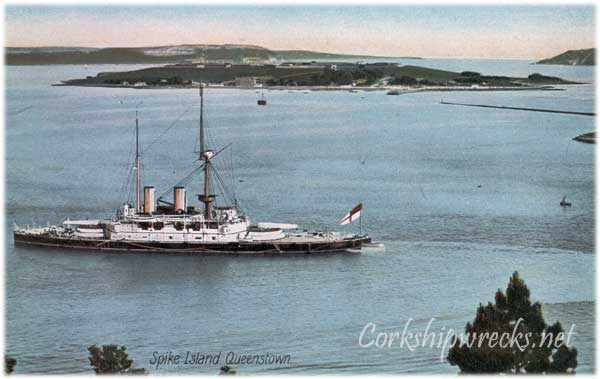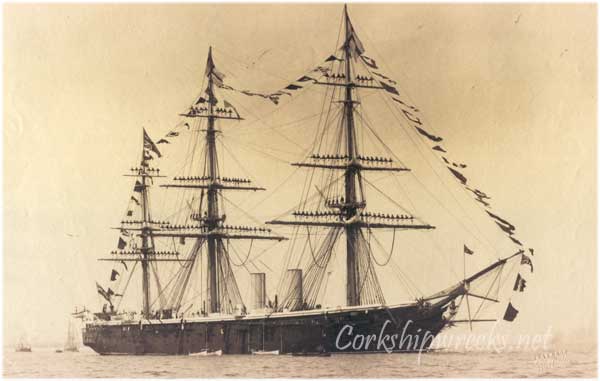
There is documentary evidence of British naval activity in Cork from the 15th Century. Under a charter of Edward IV, the Lord Mayor of Cork was created Admiral of the Port, though this was largely a ceremonial office .
Kinsale was considered the chief naval port of Ireland until the late 18th Century. In 1805 the Cove of Cork was made station of a Port Admiral, under Rear Admiral Drury. From then onwards, Cork Harbour eclipsed Kinsale. The harbour of Cork had far greater capacity for mooring and manoeuvering of merchant convoys and naval vessels.

HMS Bellepheron and HMS Mersey in Queenstown 'Roads' circa 1868
The Admiral Commanding in Ireland was based in Cove from 1797 to 1922. There was no Admiral in port between June 1831 and June 1843. From 1919 to 1922 the command name was changed to Commander in Chief, Western Approaches. .
The Royal Navy still had ships stationed in Cork, until the handing over of the harbour forts to the Irish Government in 1938. Even after WW2, there were four British minesweepers stationed here in 1946 and 1947 dealing with post-war mine clearence.
In the 18th and 19th Centuries, there was only a limited naval presence, including a port guard ship/flagship, a training ship with a roving training fleet, as well as smaller craft including coastguard vessels. There was also the static static hulk of the prison ship HMS Surprise , for both political prisoners and others. From the later 19th Century There would have been a significant turnover of ships using Haulbowline dockyard for repairs and refitting.

HMS Howe at Queenstown, with Spike Island in background
There were increases to the amount of naval ships stationed in Cork periodially. These were usually during times of crisis, or perceived threat.
Examples were:-
The various wars with France, Spain and Holland.
The American War of Independence,
The American Civil War,
A squadron of provisioning ships during the Irish Famine.
The Fenian Uprising,
World War One,
The Irish War of Independence
The Irish Civil War.
There would also have been occasional visits from the Atlantic and Channel Fleets on manouveres. For young officers however, Cork was seen as a backwater in terms of a career move.Cork was valuable as a training base.
In the early part of the 19th Century, the training brig HMS Wizard was based here. Latterly HMS Black Prince was used as a floating training establishment. This ship was permanently moored in Monkstown Bay, and had it's own pier built from the Ringaskiddy shore. There was also a training/sports ground constructed in Ringaskiddy for the boys of the Black Prince .
This vessel was used in tandem with a training squadron, usually a collection of elderly/obsolete ships.

The Queenstown Training Ship HMS Black Prince
World War One brought an unprecedented increase in the naval forces in the harbour, especially from 1915 onwards. From May 1917 there were also destroyers and support ships of the US Navy based in the harbour. From August 1917 to February 1918 it was an assembly point for convoys.
After Ireland's independence, under the terms of the Anglo-Irish Treaty, the Royal Navy presence generally consisted of two destroyers, with one usually anchored in the Cobh roads, opposite Haulbowline, and another on roving patrol. These 'guard ships' were withdrawn in 1938.
Evidence of the Royal Navy is still visible throughout the harbour, including the various structures on Haulbowline, the armoury on Rocky Island, and Admiralty House in Cobh.
